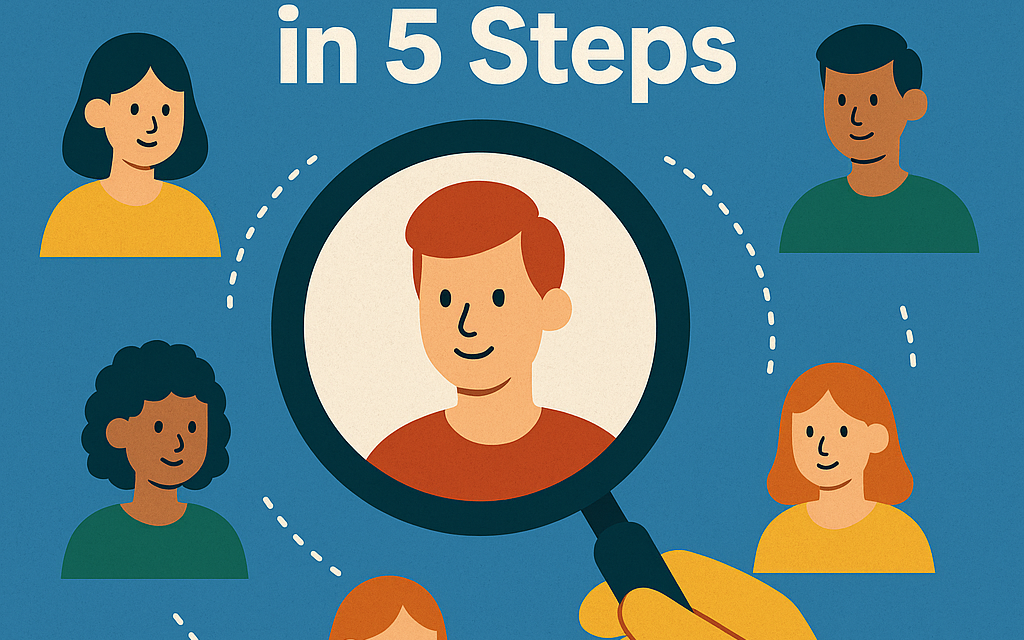How to Find Your Ideal Customer in 5 Steps (for creators in their late 20s and early 30s)
You already know how to shoot, record, and edit. The next level isn’t better cameras—it’s better fit. When your offer, content, and audience align, growth gets easier, sales feel natural, and you stop guessing. Here’s a practical, creator-friendly system to define and validate your ideal customer in five steps.
Step 1: Get crystal clear on the outcome you deliver
– Write a transformation statement: I help [who] achieve [specific result] without [key objection] in [time frame or context].
– Examples:
– I help first-time founders create authority-building short videos without hiring a full crew.
– I help boutique gyms fill trial classes using 30-second verticals filmed on phones.
– List the top 3 painful problems you solve and the 3 welcome gains you create.
– Problems: wasted ad spend, inconsistent content, no clear message.
– Gains: predictable leads, authority, time saved.
– Define deal-breakers (anti-ideal): tiny budgets, unclear decision makers, industries you won’t serve, values misalignment.
– Quick worksheet
– Best results I’ve produced:
– Who got those results:
– What was different about them vs. everyone else:
– What they said right before buying (exact phrasing from messages/emails):
– Output: a one-sentence transformation, a 3×3 list of pains/gains, and an anti-ideal checklist.
Step 2: Audit real signals from your audience and content
Stop guessing; mine the data you already have.
– Pull the top 10% of your content by:
– Watch time, saves, shares, and comments (YouTube Studio, IG/TikTok analytics).
– Click-throughs and conversion (UTMs in Linktree/Beacons/website, GA4).
– Revenue (Shopify/Stripe/Kajabi, booking tools).
– Comment and DM mining
– Copy phrases customers use about problems/results into a spreadsheet. Tag by theme (e.g., “no time,” “don’t know what to post,” “hate being on camera”).
– Competitor and adjacent creator research
– Read 20–30 reviews or comments on similar offers (Reddit, App Store, G2, Amazon for books/tools your audience uses). Capture pains, desired outcomes, and objections in their words.
– Trigger moments
– Identify life/business moments that precede buying: new job, product launch, wedding season, funding round, moving to a new city, new baby, rebrand, gym opening, seasonality.
– Output: a “signal board” with the exact language your buyers use, the content topics that convert, and 3–5 common buying triggers.
Step 3: Talk to 10–15 humans and survey 50 more
Short, structured conversations beat long, vague forms.
– Recruiting
– DM past clients, most engaged commenters, and email subscribers.
– Offer a small incentive (gift card, audit, template).
– Screener: ensure they match your target situation and have budget/authority.
– Interview flow (20–30 minutes; record and transcribe)
– Tell me about the moment you realized you needed help.
– What have you tried? What worked? What didn’t?
– If we solved this perfectly, what would be different next month?
– What would make this a “no” even if you liked the offer?
– How would you explain this purchase to a friend or boss?
– Budget ranges and buying process (who else must approve?).
– Survey tips
– Keep it to 5–7 questions, mix multiple choice with one open text.
– Ask for rankings: Which matters most? Speed, price, quality, done-for-you, training.
– Synthesize
– Theme the answers: top 5 pains, top 5 outcomes, top objections, preferred channels, decision criteria.
– Output: a validated list of real problems, buying objections, price tolerance, and channel preferences.
Step 4: Build a sharp ICP and 1–2 tight personas
ICP (Ideal Customer Profile) defines the type of customer who gets outsized value from you; personas humanize them.
– ICP essentials (B2C or solo buyer)
– Must-haves: income/budget range, problem urgency, decision authority, channel habits, timeline.
– Nice-to-haves: location, hobbies, brand affinities.
– Red flags: “picks your brain,” slow responses, needs to convince three people, wants spec work.
– Persona template
– Name, age, role/income, location
– Situation trigger
– Goals and KPIs (how they measure success)
– Pains and fears
– Buying criteria (what matters most)
– Objections and how to answer
– Primary channels (where they hang out)
– A quote in their voice
– Example persona 1 (service buyer)
– Jordan, 29, boutique gym owner, urban, mid-5-figure monthly revenue
– Trigger: opening second location; needs consistent new members
– KPIs: trial bookings/week, show-up rate, cost per booking
– Buying criteria: speed to results, local proof, easy to implement
– Objection: “We tried ads; they didn’t work.” Response: show 3 short local case clips + guarantee on trials booked.
– Channels: Instagram, Google Maps reviews, local FB groups
– Quote: “If I can fill 20 trial spots weekly, we’re good.”
– Example persona 2 (info/DIY buyer)
– Maya, 31, e-commerce founder
– Trigger: paid ads getting expensive; needs organic video to work
– KPIs: content-led sales, email signups, CTR from IG/TikTok to site
– Buying criteria: plug-and-play templates, proof, community
– Objection: “I don’t have time.” Response: 3 scripts, 30-minute batch system, content calendar.
– Channels: TikTok, YouTube, Shopify apps, Reddit ecom subs
– Quote: “Give me a repeatable system I can keep doing.”
Step 5: Test your assumptions with fast, low-cost experiments
Build a minimum viable funnel and validate in 14–21 days.
– Offer tests
– Package the same service three ways: speed-focused, done-for-you, and coaching/DIY. Keep one variable different at a time (delivery, price, or guarantee).
– Message tests
– A/B test hooks that mirror your persona’s exact words from Steps 2–3.
– Example hooks for Jordan (gym owner):
– “Fill 20 trial classes this month with 3 phone-shot Reels.”
– “Stop boosting posts. Use this 2-mile radius Reel sequence to book locals.”
– Channel tests
– Organic: post 6–9 variations across the top two channels your persona uses.
– Paid: run a small $100–$300 test to the same landing page. Success metric: cost per lead below target or 5–10 qualified DMs booked.
– Landing page basics
– Headline mirrors your best-performing hook.
– 3 bullets: pain, promise, proof.
– One CTA (book call, buy template, join waitlist).
– Add 2–3 short proof clips or screenshots.
– Success thresholds (adjust to your prices)
– Services >$1,000: 5–10% call-book rate from visitors, 30–50% close rate from qualified calls.
– Products <$200: 2–4% conversion rate or CAC under 30% of price.
– Iterate
– Keep what hits threshold; kill what doesn’t.
– Update the ICP and persona with what actually converted.
Where to find your ideal customer (fast paths)
– Instagram/TikTok
– Hashtag stacks: #[city]+[industry] (e.g., #austinfitness), #[problem] (e.g., #smallbusinessmarketing).
– Comment mining on posts with 10k–250k views; reply with value and DM an audit offer.
– YouTube
– Search problem-first titles (“how to get gym members”, “tiktok product video ideas”). Filter by this year; DM creators whose audiences match your ICP about partnerships or pinned comments.
– LinkedIn
– Boolean: title AND industry AND city (e.g., “owner” AND “fitness” AND “Denver”). Connect with a short, specific value line and a 30-second loom.
– Reddit/Discord/Slack
– Answer problem threads with one concrete step and a no-pitch resource. Track which sub-communities generate replies.
– Events and local
– Niche meetups, coworking spaces, chamber groups. Offer a free mini workshop; capture emails via a QR code.
Your messaging matrix (use this to write posts, pages, and scripts)
– Column 1: Pain in their words
– Column 2: Promise tied to a measurable outcome
– Column 3: Proof (clip, stat, testimonial, before/after)
– Column 4: CTA aligned to their stage (audit call, template, waitlist)
– Example for Jordan (gym owner)
– Pain: “Our trial classes are half-empty.”
– Promise: “20 trial bookings in 14 days within 2 miles.”
– Proof: 3 Reels, 37 bookings in 12 days for a similar gym.
– CTA: “DM ‘TRIALS’ for the 3-Reel plan.”
Interview and survey swipe files
– DM outreach
– “Hey [Name], I’m refining a [result]-focused service for [who]. Could I ask 5 quick questions? I’ll share the takeaways and a custom tip for you.”
– Screener questions
– What are you trying to accomplish in the next 60 days?
– What have you tried so far?
– What budget range have you set aside?
– Who else needs to approve this?
– Interview questions
– Walk me through the last time you tried to solve this.
– What made you pick that solution?
– What almost stopped you from moving forward?
– If this works, what does success look like in numbers?
– If you had to choose, which matters most: speed, price, or quality?
Metrics that matter (and what they tell you)
– Audience fit: save rate, share rate, and average watch time on problem-first content.
– Pipeline: qualified DMs, discovery calls booked, show-up rate.
– Conversion: close rate, time-to-close, objection themes.
– Unit economics: CAC vs. price, refund/chargeback rate, LTV or repeat purchase rate.
– Retention/advocacy: client referral rate, testimonial volume, UGC created.
30-day action plan
– Week 1: Step 1–2. Write your transformation statement, mine analytics, collect 50 comments/phrases, define triggers.
– Week 2: Step 3. Run 10–15 interviews, 50-response survey, synthesize themes.
– Week 3: Step 4. Build 1–2 personas, finalize ICP, craft messaging matrix and anti-ideal list.
– Week 4: Step 5. Launch two offers and three hooks. Run a small paid test and daily organic variations. Measure, then iterate.
Common mistakes to avoid
– Building for who you can reach, not who gets outsized value.
– Personas that read like horoscopes (too broad) or like a single friend (too narrow).
– Changing too many variables at once in tests.
– Ignoring anti-ideal red flags because you “need the sale.”
– Over-indexing on vanity metrics; revenue and qualified pipeline are the real fit checks.
If you want, tell me what you sell, your top-performing post, and your last three customer wins. I’ll help you draft a one-sentence transformation, an ICP, and the first three experiments to run.





